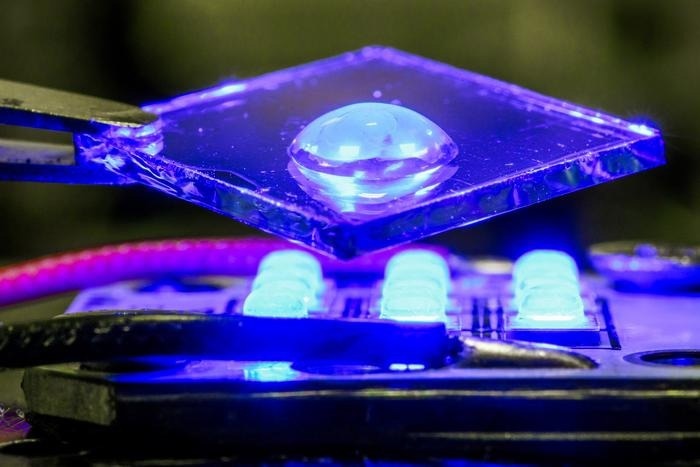Recently, scientists at Linköping University, Sweden, have devised an innovative approach, leveraging air as a dopant to enhance the conductivity of organic semiconductors. Published in the journal Nature, this research marks a substantial advancement toward affordable and eco-friendly organic semiconductor technology.

The new method involves dipping the conductive plastic into a special salt solution – a photocatalyst – and then illuminating it with light for a short time resulting in a p-doped conductive plastic in which the only consumed substance is oxygen in the air. Image Credit: Thor Balkhed
We believe this method could significantly influence the way we dope organic semiconductors. All components are affordable, easily accessible, and potentially environmentally friendly, which is a prerequisite for future sustainable electronics.
Simone Fabiano, Associate Professor, Linköping University
Conductive plastic-based semiconductors, as alternatives to silicon, offer a wide range of potential applications. Organic semiconductors hold promise for digital displays, solar cells, LEDs, sensors, medical implants, and energy storage solutions.
To improve conductivity and modify the characteristics of semiconductors, dopants are commonly used. These additives facilitate the movement of electrical charges within the semiconductor material and can be tailored to introduce positive (p-doping) or negative (n-doping) charges. However, the most commonly used dopants tend to be highly reactive, unstable, expensive, or difficult to produce, which presents significant challenges.
To this end, researchers at Linköping University have pioneered a room-temperature doping technique where inefficient dopants, such as oxygen, serve as the primary dopant. This innovative doping process is activated by light.
Our approach was inspired by nature, as it shares many analogies with photosynthesis, for example. In our method, light activates a photocatalyst, which then facilitates electron transfer from a typically inefficient dopant to the organic semiconductor material.
Simone Fabiano, Associate Professor, Linköping University
In this novel method, the conductive plastic is immersed in a unique salt solution that acts as a photocatalyst and then exposed to light for a brief period. The duration of illumination determines the extent of doping in the material. Afterward, the solution is reclaimed for future use, leaving behind a p-doped conductive plastic, with oxygen from the air being the only consumed substance.
This process is feasible because the photocatalyst functions as an "electron shuttle," either accepting or donating electrons to the material in the presence of sacrificial weak oxidants or reductants. While this concept is well-established in chemistry, its application in organic electronics represents a new advancement.
It’s also possible to combine p-doping and n-doping in the same reaction, which is quite unique. This simplifies the production of electronic devices, particularly those where both p-doped and n-doped semiconductors are required, such as thermoelectric generators. All parts can be manufactured at once and doped simultaneously instead of one by one, making the process more scalable.
Simone Fabiano, Associate Professor, Linköping University
The doped organic semiconductor boasts better conductivity than traditional semiconductors, and the process can be scaled up. In early 2024, Simone Fabiano and his research group at the Laboratory of Organic Electronics demonstrated how conductive plastics could be processed using environmentally friendly solvents like water. This novel doping technique represents their next step in advancing the field.
“We are at the beginning of trying to fully understand the mechanism behind it and what other potential application areas exist. But it’s a very promising approach showing that photocatalytic doping is a new cornerstone in organic electronics,” concludes Simone Fabiano, a Wallenberg Academy Fellow.
Journal Reference:
Jin, W., et al. (2024). Photocatalytic doping of organic semiconductors. Nature. doi.org/10.1038/s41586-024-07400-5.